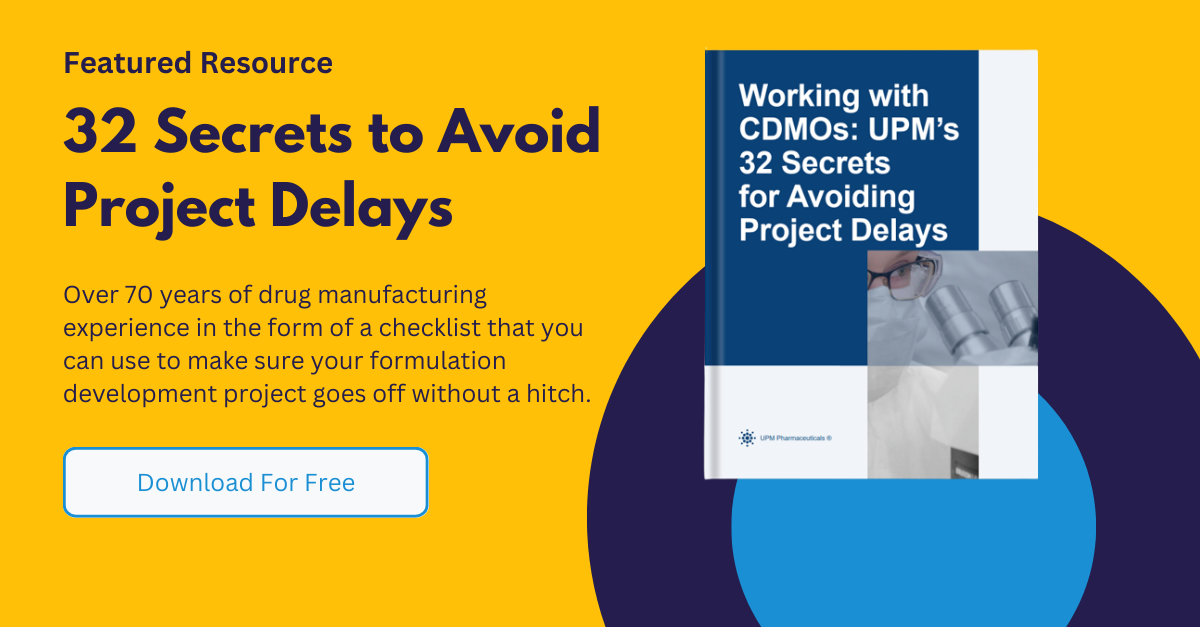Oral solid dosage (OSD) refers to pharmaceutical formulations that are taken by mouth in a solid form, such as tablets, capsules, or powders. These dosage forms are designed to be swallowed and dissolved in the gastrointestinal tract, allowing for the systematic delivery of the active pharmaceutical ingredient to the body.
But what are the types of OSD, and the manufacturing processes? Keep reading to learn more.
Types of Oral Solid Dosage Forms
Oral solid dosage (OSD) products come in different forms, including tablets, buccal and sublingual tablets, chewable tablets, and capsules.
- Tablets are the most common form of OSD and are made by compressing a mixture of active pharmaceutical ingredients (API) and excipients.
- Buccal and sublingual tablets are designed to dissolve in the mouth and are often used for drugs with a rapid onset of action.
- Chewable tablets are formulated for patients who have difficulty swallowing tablets or capsules.
- Capsules consist of a shell that encloses the API and excipients in either a powder or granule form.
Understanding the differences between these OSD forms is essential for the development of effective drug therapies.
Tablets
Tablets are the most prevalent form of oral solid dosage products, and their diverse range includes immediate-release, sustained-release, and controlled-release varieties, each designed to meet specific drug delivery needs and enhance patient outcomes.
The manufacturing process of tablets involves blending the active ingredient with pharmaceutical ingredients and dry powder excipients, followed by granulation or direct compression.
Granulation is a wet granulation process that involves adding a liquid binder to the powder mixture to create granules, which are then dried, sieved, and compressed into tablets. Direct compression, on the other hand, involves directly compressing the powder mixture into tablets without the need for granulation.
The type of tablet formulation used depends on the drug's physicochemical properties, therapeutic indication, and patient needs.
- Immediate-release tablets are designed to release the active ingredient immediately after ingestion
- Sustained-release tablets release the drug over an extended period to maintain therapeutic levels
- Controlled-release tablets release the drug gradually over a specific period to achieve a steady-state concentration
Tablets are a popular choice for oral solid dosage pharmaceuticals due to their ease of manufacturing, administration, and stability.
Buccal and Sublingual Tablets
Buccal and sublingual tablets are advantageous for drugs that require rapid delivery and bypassing the digestive system, making them an effective option for patients with specific therapeutic needs.
Buccal tablets are designed to dissolve between the cheek and gum, while sublingual tablets are placed under the tongue. Both types of tablets allow for the drug to be absorbed directly into the bloodstream, bypassing the digestive system. This is particularly helpful for drugs that are destroyed by stomach acid or not well absorbed through the gut.
Buccal and sublingual tablets are ideal for drugs that need to be delivered quickly to the body, such as nitroglycerin for chest pain.
To develop effective buccal and sublingual tablets, it is essential to consider the physicochemical properties of the raw materials used. The distribution of ingredients in the tablet and the release of dosage forms should also be taken into account.
A well-designed tablet will ensure that the drug is released at a controlled rate and that the tablet dissolves completely in the patient's mouth. Despite their advantages, buccal and sublingual tablets can be messy to take and may not be suitable for all drugs. Careful consideration of the specific therapeutic needs of the patient is essential when choosing between different oral solid dosage forms.
Chewable Tablets
Chewable tablets have gained popularity in recent years due to their convenience and ease of use for individuals who have difficulty swallowing compressed tablets. These tablets are designed to be chewed and swallowed, allowing for the active ingredient to be released and absorbed through the lining of the mouth.
Chewable tablets are a type of oral solid dosage (OSD) form, which refers to a final drug product therapy ingested through the mouth and absorbed into the bloodstream.
Chewable tablets have several advantages over other OSD forms. Such as:
- Chewable tablets are initially broken down into particles in the oral cavity, which makes them easier to swallow.
- They have unique physical properties that allow them to quickly break down in the stomach's digestive fluid, resulting in better absorption of the active ingredient into the body.
- Chewable tablets provide precise dosing, ensuring that patients receive the accurate amount of medication required for their treatment
- They offer stability benefits, meaning they have a longer shelf life compared to liquid medications, ensuring their effectiveness for a longer period of time.
- Chewable tablets are particularly suitable for patients who struggle with swallowing, such as elderly individuals, children, and those with swallowing difficulties like dysphagia.
Clinical trials have shown that chewable tablets have comparable efficacy to other solid-dosage drugs, making them a viable option for a variety of dose forms.
Capsules
Capsules are a versatile oral drug delivery system that offers a range of options for drug formulation and delivery. They consist of a shell made of either gelatin or polymer material that encloses the API and dry powder ingredients. Capsules come in two main types: hard and soft. Hard capsules are made of gelatin, while soft capsules can be made from a variety of materials, including vegetable oil and other polymers. Each type of capsule has its own unique benefits and drawbacks, making them suitable for different drug formulations and delivery methods.
To create a capsule, the API and dry ingredients are first mixed together and then filled into the capsule shell. Capsules can be made using various processing techniques, such as wet granulation, dry granulation, and coating processes. The type of processing used depends on the specific drug formulation and desired release profile. Capsules can also be used for modified-release formulations, such as enteric-coated capsules, which dissolve in the small intestine rather than the stomach. Product development reports and studies are crucial for ensuring the quality and consistency of capsule formulations. Overall, capsules are a popular and effective oral solid dosage form that offers flexibility in drug formulation and delivery.
4 Benefits of Choosing OSD as Your Drug Formulation Type
Opting for oral solid dosage (OSD) forms offers a multitude of benefits for pharmaceutical companies looking to balance efficiency and cost-effectiveness.
1. Convenience and Patient Compliance
Opting for oral solid dosage (OSD) forms offers a multitude of benefits for pharmaceutical companies looking to balance efficiency and cost-effectiveness. OSD forms, such as tablets and capsules, allow for improved patient compliance as they offer convenient administration, allowing patients to take their medication without the need for healthcare professional involvement. This convenience leads to more effective treatment outcomes and improved patient satisfaction.
2. Accurate Dosing and Uniform Drug Content
Oral solid dosage forms allow for precise dosing, and ensure the accurate delivery of the prescribed amount of medication. They provide uniform drug content, minimizing variations in dosage and enhancing consistency in drug administration.
3. Stability and Shelf Life
Another advantage of OSD forms is their extended shelf life and stability. Compared to liquid or semisolid formulations, OSD forms are generally more stable and have a longer shelf life. They can retain potency over time and are less susceptible to degradation or contamination when stored correctly. This stability ensures that the medication remains effective throughout its intended shelf life, making OSD a reliable solution for pharmaceutical companies looking to meet the demands of global supply chains while maintaining product quality and ensuring patient safety.
4. Clinical Development and Control Processes
Choosing OSD forms also offers competitive advantages to pharmaceutical companies in terms of clinical development, production cost, and control processes. OSD forms allow for easier clinical development as they are simple to manufacture and can be easily scaled up. Moreover, OSD forms can be produced at a lower cost than other drug formulation types, as they require less equipment and fewer processing steps. Additionally, OSD forms offer better control processes, as they can be easily analyzed and tested to ensure product specifications are met, leading to more consistent and reliable product quality.
Questions & Considerations When Choosing OSD as your Drug Formulation Type
Selecting the appropriate drug formulation type involves assessing various factors, such as the properties of the API, release profile, and patient needs, which are critical considerations in the decision-making process.
- The properties of the API play a significant role in determining the feasibility of creating an oral solid dosage (OSD) form. Some chemical entities are more challenging to formulate into tablets or capsules, as they may be sensitive to heat or moisture. Therefore, it is important to work with a qualified pharmaceutical expert who can assess the API and determine the best approach for creating an OSD form.
- The desired release profile: Immediate-release dosage forms rapidly release the API into the bloodstream, while sustained-release and controlled-release formulations release the drug over a more extended period. The desired release profile will depend on the therapeutic goals of the drug. It is essential to ensure that the OSD drug formulation meets the desired release profile and undergoes a rigorous validation process before being released to the market.
- The patient's needs: Some patients may have difficulty swallowing tablets or capsules, and in such cases, alternative OSD forms, such as chewable tablets or liquid suspensions, may be more appropriate. Therefore, it is essential to consider the patient's preferences and requirements when selecting the OSD formulation type.
- Continuous manufacturing is a modern approach that integrates individual batch unit operations into a single continuous process, making OSD production more efficient and cost-effective. Tablet testing is also an essential step in ensuring that the OSD drug formulation meets the required quality standards.
Choosing a CDMO
Choosing the right CDMO partner is critical for the success of your drug project. When evaluating potential CDMO partners, it is important to consider the following factors:
- Experience: The CDMO should have experience in manufacturing OSDs. They should also have experience with the specific API and dosage form that you are developing.
- Capabilities: The CDMO should have the capabilities to manufacture your drug at the scale and quality that you need. They should also have the flexibility to adapt to changes in your requirements.
- Quality: The CDMO should have a strong commitment to quality. They should have a robust quality management system in place and should be able to demonstrate their compliance with cGMP regulations.
- Cost: The cost of manufacturing your drug will vary depending on the CDMO that you choose. It is important to compare the costs of different CDMOs to ensure that you are getting the best possible value for your money.
Once you have evaluated potential CDMO partners, you can select the one that best meets your needs. Working with a qualified CDMO partner can help you to bring your drug to market more quickly and efficiently.
Download Now: 32 Secrets to Avoid Project Delays [Free eBook]
CONTACT US
Partner with a Qualified CDMO: UPM Pharmaceuticals
Bringing a new drug to market is a lengthy, costly, and risky journey, compounded with the time pressure of being first in the marketplace. UPM is unlike other CDMOs because we are a large pharma supplier and an independent, family-owned CDMO, allowing us greater flexibility in our partnerships. To this point, our ended-to-end CDMO services have helped bring over 80 pharma products to market.
Our state-of-the-art seven-acre pharmaceutical campus features our commercial manufacturing and packaging site, commercial warehouse, and DEA-Approved vault. With extensive pharmaceutical industry experience and a solid track record of bringing drug products to market, our capabilities are the best that commercial pharma has to offer. Contact UPM to learn more about our contract development and manufacturing organization and how we can optimize your pharmaceutical project results.
Connect with Our CDMO Services

